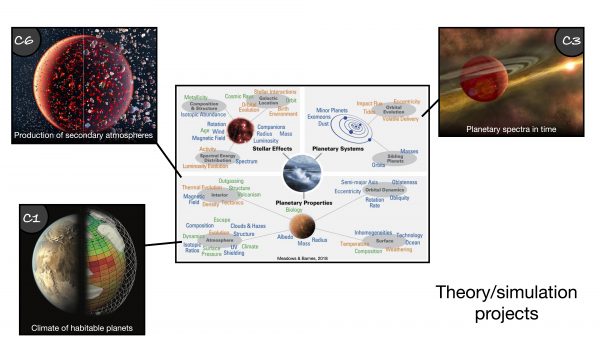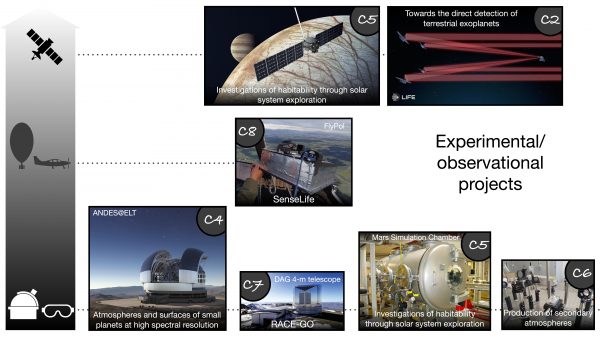Domain C
In this latest phase of research of PlanetS, a bigger emphasis is placed on the topic of habitability, which includes searching for signs of life beyond Earth. This is a natural evolution of the research field of exoplanets (after their detection and characterisation) and has always been a hot topic in Solar System science (was there ever life on Mars?). This evolution is also based on years of successful collaborations within PlanetS and reflects a key scientific interest of our researchers.
By definition, the research focusing on “Habitability and the search for life” requires a multi-disciplinary approach. Domain C has therefore strong ties with Domain A (Formation and architecture of planetary systems) as it provides the initial conditions from which habitability can develop and Domain B (Physics and characterisation of planets) as it provides better observational constraints on the planets which can be potentially hosting life. To exemplify this interdisciplinarity, there is a working group (link to WG1 to be added) focused on “Spectroscopic biosignatures in planetary atmospheres” in which Domain C has a strong interest and in which scientists from both Domains A and B are involved. Finally, this interdisciplinarity is also visible in the wide scientific range of the projects in the domain (see list below) and the links between these projects with Domain A and B projects.
In more details, Domain C has the goal of improving our understanding of “habitability”. We have a dual approach, focusing on both theoretical models and observational techniques. The theoretical models aim to understand the formation and evolution of atmospheres of potentially habitable planets (Projects C1, C3, C6), while the observational techniques aim to detect signs of habitability and life beyond Earth (C2, C4, C5, C7, C8). Most projects focus on exoplanets while projects C5 and C8 focus on the detectability of life on our Solar System.


Domain C has already achieved several milestones, including publications in peer review journals, and the development of advanced optical simulations for ground-based instruments.
The different projects of Domain C are:
- Project C1: Climate Of Habitable Planets (Pl: Prof. Emeline Bolmont, UGE)
This project aims to study the potential habitability of exoplanets. In one part of the project, a student is investigating how many stable climate states a planet can have and how this changes our view of the habitable zone. One aspect of that work consists in improving the ocean module of a 3D climate model to better simulate the effect of the circulation of oceans on the climate exoplanets. In another part of the project, another student is using the same climate model to study specific potentially habitable exoplanets whose atmosphere could be characterised with the instrument ANDES for the ELT (Link with Project C4). She is now focusing on a planet called Ross-128 b and will explore different possible atmospheres and how different dynamical states could affect the planet’s habitability and future characterisation.
- Project C2: Towards The Direct Detection Of Terrestrial Exoplanets (Pl: Prof. Sascha Quanz, ETHZ)
This project is divided into five parts. The first part involves searching for exoplanets around nearby stars using different techniques and combining data to understand more about the types of planets that exist. The second part involves using a satellite to study Earth as an exoplanet and search for atmospheric signatures that may indicate the presence of life. The third part looks at using the chemical composition of nearby stars to identify which ones are more likely to have terrestrial exoplanets, which are similar to Earth. The fourth part involves simulating the spectra of terrestrial exoplanets and assessing how well they can be characterized by future observations, which is important for planning future space missions. The fifth part involves developing a technique called “nulling interferometry” in the lab, which is important for future mid-infrared interferometry missions, such as the LIFE mission.
- Project C3: Planetary Spectra In Time (Pl: Prof. Christoph Mordasini, UBE)
The project aims to better understand how planets form and evolve by studying their atmospheres. The project is divided into four parts. In the first part, the team will improve the accuracy of models used to predict the structure of planetary atmospheres by using fully non-grey atmospheric models. In the second part, they will study how planets that are still in the process of forming accrete gas from their surrounding disks. In the third part, they will create a database of planetary atmospheric spectra and compare these to observations to learn more about how planets form and evolve. Finally, in the fourth part, they will study how cosmic rays can affect the chemical composition of planetary atmospheres and what this means for interpreting observations of these planets.
- Project C4: Atmospheres And Surfaces Of Small Planets At High Spectral Resolution (Pl: Prof. Christophe Lovis, UGE)
This project aims to study exoplanets using a variety of techniques. In the first part of the project, the team will use new spectrographs to study the atmospheres of smaller exoplanets in order to determine their composition and structure. In the second part, they will simulate the atmospheres and surfaces of potentially habitable exoplanets in order to produce realistic high-resolution spectra (link with Project C1). The third part of the project involves building a new instrument called RISTRETTO that will allow the team to study nearby exoplanets in reflected light. In the fourth part, the team will provide scientific support to the future project ANDES at the ELT which aims to study a sample of habitable exoplanets using a high-resolution spectrograph planned for 2030. Finally, in the fifth part of the project, the team will work on building a comprehensive catalogue of nearby exoplanets using radial-velocity surveys.
- Project C5: Investigations Of Habitability Through Solar System Exploration (Pl: Dr. Antoine Pommerol, UBE)
This project aims to understand more about the moons of Jupiter and Mars. The first part of the project involves studying the Galilean satellite system, which includes the moons of Jupiter, to detect recent surface activity and investigate the properties of icy analogues in the lab. The second part of the project is focused on setting up a new infrastructure for the analysis of returned extra-terrestrial samples using a new instrument with high resolution capabilities. The third part of the project involves developing new imaging techniques to study Mars and its habitability using polarimetric and infrared imaging, which could improve our chances of contributing to future missions.
- Project C6: 2ATMO – Production Of Secondary Atmospheres (Pl: Prof. Paolo Sossi, ETHZ)
The atmosphere of a planet affects its ability to support life and can tell us about what’s inside it. However, we don’t yet know how to use observations of exoplanet atmospheres to learn about their interiors. Additionally, there are many ways that a planet’s atmosphere can be created that don’t involve life, which can make it difficult to tell if a planet is habitable. To address this, this project will use laboratory equipment (a kind of furnace) to simulate how atmospheres are formed around rocky planets. By studying the outcome of these experiments, they hope to learn more about what kinds of atmospheres can be expected on exoplanets and how to distinguish between habitable and uninhabitable planets.
- Project C7: RACE-GO – Rapid Active Coronagraphy Of Exoplanets From A Ground‐Based Observatory (Pl: Prof. Jonas Kühn, UBE)
RACE-GO is a project that aims to improve the imaging of planets outside of our solar system. The project will use the latest liquid crystal display technology to create images that are clearer and more detailed. The team will combine this technology with high-speed infrared cameras to explore a new method called Coherent Differential Imaging (CDI). CDI allows scientists to distinguish between atmospheric disturbances and actual objects, making it easier to locate exoplanets. The project will fund an upgrade to an existing imaging instrument and test it on the DAG 4-m telescope in Turkey. The goal is to eventually bring this technology to larger observatories and telescopes.
- Project C8: SenseLife – Remote sensing of living organisms with full-Stokes spectro-polarimetry (PI: Brice Olivier-Demory, UBE)
SenseLife is a project that aims to use a special technique called full Stokes spectro-polarimetry to find living organisms in the outer Solar System. They will build special instruments called FlyPol to do this and use them to study different types of living things in harsh environments like glaciers and mountain lakes. They will collect data about these organisms and use it to create a database of information that can be used to understand how to find life on the icy moons of the solar system. The project will also help scientists understand more about how different living things survive in tough environments and use this information to better identify some consequences of global warming and improve cancer diagnosis.

